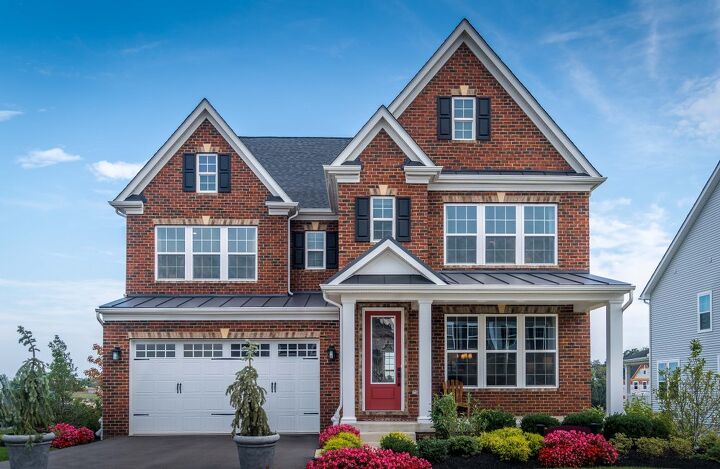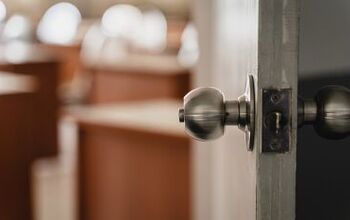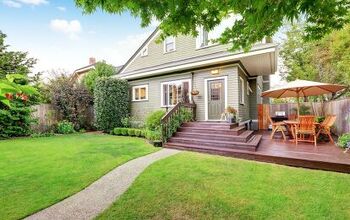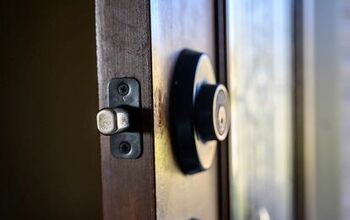What Is Brickmold On A Door?

If you have ever looked at an exterior door, and wondered what all the trim boards are there for, then you may be wondering, what is brickmold? Brickmold is an aesthetic piece and makes any door casing look complete.
Brickmold is a type of trim that creates a barrier between the door frame and the siding. This trim helps protect against the weather and creates a unique and comfortable aesthetic. Brickmold trim can also increase security because of how sturdy and strong they are.
Door frames and windows, sometimes need a little extra flair in their designs. This is where brickmold comes in. It is an extra trim piece, that adds complexity to the design, and helps make the transition between the wall and the door frame, look better.
What is the Purpose of Brickmold?
Although brickmold is optional, it does have many benefits, that can increase the life of your doors and windows. The main purpose of the brickmold is to act as a barrier between the exterior wall, and the door casing.
The brickmold serves as an extra layer of protection, between your door and the wall, shedding water, and keeping insects out. This can add years onto the life of the door. The next reason for brickmold is that it adds an extra aesthetic to your door. The brickmold comes in more than one design type, and you can choose to have something simple, or extra decorative.
You could also decide to paint the brickmold a different color than the trim, using colors that go well together, adding an interesting look to your entryway. It gives you a surface to pin Christmas lights and other decorations.
Brickmold vs. No Brickmold
You know what brickmold is now, however, what is the difference between having it, and not having it? There are a few things to consider when deciding on whether or not to use brickmold.
- Do you want your entryway to have a little more style? This is the main reason to want brickmold on a doorframe. It adds style and character.
- Do you want to extend the life of your doorway? Brickmold makes doorframes last longer, without as much rot, by adding an extra layer of protection.
Professionals recommend using brickmold. This is for the added benefit of protection, and the extra design elements. However, it is still a matter of preference.
There can be design benefits to not using brickmold as well, such as a sleek-looking, minimalist design. Some windows are already very decorative, and by not using brickmold, you let their style pop on their own.
Installation and materials cost more when using brickmold, but the added life you give to your windows can be well worth the investment. Using brickmold can add 10-20 years onto the life of your entryway.
Benefits of Installing Brickmold
Aside from extending the lifespan of your doors, there are a number of other benefits associated with installing brickmold. A door serves as the entrance and point of security for your entire home. Because of this, it is vital that you choose a type of door that is both secure and durable. Adding brickmolding onto your exterior doors can provide just that, and more.
The following are some of the benefits to installing brickmold:
- Protects against weather. Brickmolding, particularly those made of PVC, are resistant to moisture. It can safeguard the door frame from retaining moisture and possible rot.
- Increases durability. Doors with brickmold are considerably more durable than those without. Installing brickmold around your door frame protects the plaster from chipping. Although it cannot give you a lifelong guarantee, it can significantly prevent doors from experiencing wear and tear.
- Added security. There is no doubting that doors with brickmold are much more secure than conventional exterior doors. It serves as an additional frame, making possible break-ins especially difficult.
- Cozy aesthetic. Most people opt for doors with brickmold to achieve a more cozy, homey aesthetic for their home. Doors without brickmold display a more sleek look and are often seen on commercial buildings. As a result, though it does ultimately come down to preference, most prefer the visually appealing nature of brickmold.
Benefits of No-Brickmold Doors
Like doors with brickmold, no brick mold doors also have their own set of unique advantages. If you’re unsure about whether or not you should install brickmold on your door, consider the following benefits of a no brickmold door to help you make an informed decision:
- No additional cost. Of course, adding an extra protective frame on your door is going to come with a cost. If you don’t plan on living in your home long-term, you can ditch the installation of brickmold and save money in the process.
- Simple installation. Not only does brickmold installation come with an extra cost, it also comes with installation time and effort. To reduce time and effort, you can simply opt for a no-brickmold door.
- Basic aesthetics. If you prefer to make a statement with a simple design, or possibly a raw, industrial look, consider opting out of installing a brickmold door.
Additionally, if the brickmold is improperly installed this can lead to serious issues. If the exterior wall where the door is being installed is not level and square, the brickmold will actually be a hindrance to ensuring the unit itself is level and plumb. To install the door correctly, the brickmold may have to be removed. So, you can avoid problems like this by forgoing brickmold entirely.
Types of Brickmold Styles
Brickmold comes in multiple style variations. They can be a simple flat trim piece, or they can have decorative edges. Each style of brickmold adds a little bit of character to your already existing doorway.
Style types:
- Flat surface
- Decorative edge
- Curved edge
- Staggered edge
These design types all have their place, depending on the style you want your doorway to have. Using a flat surface may look better on minimalist designs, while a decorative, or curved edge design, may add some complexity.
All of these design types have the benefit of extending the life of your doorway, while also giving it a clean finished look.
Brickmold Materials
Brickmold comes in multiple material varieties. There is a brickmold that will match any type of doorway that you have. If your home has aluminum siding, there is aluminum brickmold, as well as vinyl.
Types of Brickmold materials:
- Softwood: Plain lumber is the most common material used in the construction of brick molding. Lumber comes in two main types of softwood – yellow or white pine. Although inadequately painted softwood cannot withstand harsh weather conditions, priming and painting it properly will extend its lifespan.
- Hardwood: A readily available and affordable choice for brickmold.
- Vinyl and PVC: Vinyl and PVC brickmold is the choice to consider if you want a casing that withstands pests, mold, and mildew. They are also much easier to install and a better alternative to softwood.
- Aluminum
- Composite: Such as extruded PVC. It gives you the strength of wood, but isn’t affected by insects and won’t rot over time. Composite brickmold is designed textured to mimic the look of real wood. To further simulate wood, composite can be painted or gel-stained.
- Stone
There is a type of brickmold, for just about any material that is used on your home. If your home is brick, a stone brickmold can look extremely well. The aluminum brickmold comes in multiple styles, that fit most aluminum siding designs.
You can go with something fancy, and a little more expensive, or something cheaper like composites. The better materials will help add more life to your doorway, while cheaper products can weather over time.
Brickmolding Costs
Having a budget can be a deciding factor, in whether or not, you will be using brickmold. However, there are options, that allow you to use high-quality material, or a lower costing material. Either way, the brickmold you choose will add life to your doorway.
Materials such as stone, and aluminum, cost more than wood or composite brickmolds. You can also choose options, like bare wood, or primed wood, that can change the overall costs.
You can expect to pay anywhere from $30-$200 per door, depending on the material and style type that you go with. In the end, it really comes down to how fancy you want your brickmold to be, and the quality of the material that is used.
Can I Install Brick Molding on a Storm Door?
There are few considerations when hanging a storm door, on a doorframe with brickmolding. The main consideration is how sturdy the material is. A cheaper composite brickmold may not hold up to the weight of the storm door, and a stone brickmold may also have limitations for installing a storm door.
The brickmold needs to be attached with screws, to make sure that it is strong enough, to hold the weight of the storm door. It can be easy to add a few long screws to wooden brickmold, and not so easy for PVC, aluminum, and stone.
You will need to check the manufacturer specs, for any details on weight limits, and other restrictions. For the most part, you should be able to install brick molding on a storm door.
What Sizes Do Brickmolds Come In?
Brickmold comes in multiple size options. These options accommodate different types of trim and materials. The standard size for wood brickmold is 1 ¼ inch by 2 inches.
Aluminum, PVC, and stone brickmold, have more options for size, based on the different styles of trim that those materials are used for. Most stone and aluminum brickmolds are around 2 ½ inches wide.
Aluminum comes in multiple sizes and is a much thinner material, based on the nature of it being thin aluminum, to match the aluminum siding. Despite it being thinner, it still adds a layer of protection and sheds water extremely well.
Related Questions
Does brickmold add to a home’s value?
According to real estate agents, brickmold can add value to your home, especially when the design pairs well with the overall look of your home. Though, there is no specific percentage of its added value to your home, as it varies quite a bit.
Is brickmolding optional on doors?
Yes, brickmolding is optional on doors. You can have a doorway without brickmold if your design is minimal. There are many advantages to having brickmold, besides the decorative purpose of it, and we recommend its use.
Why do windows have brickmolding?
Brickmolding on windows has the same purpose as on doors, to add life to the windows, and to add an element of design and style. The benefits of having brickmold on windows, outweigh not using it. We recommend using brickmold on windows.

I'm a writer that is passionate about home improvements, remodeling, and renovating. I enjoy learning new skills and techniques and sharing them with others.
More by Chad Kilpatrick



























